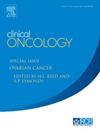Prognostic Implications of HPV Cell-Free DNA Serial Testing During Follow-Up of p16 Positive Oropharyngeal Squamous Cell Carcinoma After Curative-Intent Treatment
IF 3.2
3区 医学
Q2 ONCOLOGY
引用次数: 0
Abstract
Introduction
Plasma circulating HPV cell-free DNA has high sensitivity and specificity for the detection of HPV-mediated oropharyngeal squamous cell carcinoma. We investigated the clinical significance of serial testing after curative-intent treatments.
Materials and Methods
Patients with concordant p16 positive tumour or neck node biopsy and positive high-risk HPV plasma cell-free DNA were prospectively recruited. HPV cell-free DNA were obtained using digital droplet polymerase chain reaction (ddPCR) and were collected at diagnosis and at every clinical follow-up. Three months after completion of curative-intent treatments, patients were stratified according to treatment response on computed tomography. Complete responders (CR) were followed-up clinically, partial responders (PR) underwent further imaging and surgical/medical management if appropriate, patients with progressive disease (PD) received palliative treatments.
Results
A hundred and fourteen patients were included and 717 HPV cfDNA ddPCR samples were analysed during a median follow-up of 103 weeks (IQR, 40.2–147.8). Ninety (78.9%) patients were classified as CR, 18 (15.8%) as PR and all except one, who was rapidly diagnosed with PD, had negative HPV ddPCR at 12 weeks follow-up; 6 (5.3%) had PD and all except one had positive HPV ddPCR. Eleven had recurrent disease, 6 in the CR group (6.6%) and 5 among PR (27.7%). Ninety patients had consistently negative HPV ddPCR at all time points and one developed a recurrence (NPV 99%, 95% C.I., 93.2–99.8%). Eighteen patients developed positive HPV ddPCR and 10 developed recurrent disease (PPV 55%, 95% C.I., 38.6–71.4%). Ten patients had two consecutively positive HPV ddPCR and all had proven disease (PPV 100%, 95% C.I., 69.2–100%). Nine patients had transiently positive HPV ddPCR and none developed disease at that time.
Conclusions
Post-treatment HPV ddPCR reflected treatment response on imaging and serial testing had high PPV and NPV in detecting recurrent disease.
p16阳性口咽鳞状细胞癌治疗后随访期间HPV无细胞DNA序列检测的预后意义
血浆循环HPV无细胞DNA检测HPV介导的口咽鳞状细胞癌具有较高的敏感性和特异性。我们研究了治疗目的治疗后连续检测的临床意义。材料和方法前瞻性招募p16肿瘤或颈结活检一致阳性、高危HPV无浆细胞DNA阳性的患者。采用数字液滴聚合酶链反应(ddPCR)获得HPV无细胞DNA,并在诊断时和每次临床随访时收集。治疗目的治疗完成3个月后,根据计算机断层扫描的治疗反应对患者进行分层。完全缓解者(CR)接受临床随访,部分缓解者(PR)接受进一步的影像学检查和适当的手术/医疗管理,进行性疾病(PD)患者接受姑息治疗。结果在中位随访103周(IQR, 40.2-147.8)期间,纳入114例患者,分析了717份HPV cfDNA ddPCR样本。90例(78.9%)患者被分类为CR, 18例(15.8%)患者被分类为PR,除1例快速诊断为PD外,其余患者在12周随访时HPV ddPCR阴性;6例(5.3%)患有PD,除1例外,其余均为HPV ddPCR阳性。11例复发,CR组6例(6.6%),PR组5例(27.7%)。90例患者在所有时间点持续HPV ddPCR阴性,1例复发(NPV 99%, ci 95%, 93.2-99.8%)。18例患者出现HPV ddPCR阳性,10例复发(PPV 55%, ci 95%, 38.6 ~ 71.4%)。10例患者连续两次HPV ddPCR阳性,均确诊为疾病(PPV 100%, ci 95%, 69.2-100%)。9例患者有短暂的HPV ddPCR阳性,当时没有发生疾病。结论治疗后HPV ddPCR在影像学和系列检测中反映治疗效果,对复发性疾病的检测具有较高的PPV和NPV。
本文章由计算机程序翻译,如有差异,请以英文原文为准。
求助全文
约1分钟内获得全文
求助全文
来源期刊

Clinical oncology
医学-肿瘤学
CiteScore
5.20
自引率
8.80%
发文量
332
审稿时长
40 days
期刊介绍:
Clinical Oncology is an International cancer journal covering all aspects of the clinical management of cancer patients, reflecting a multidisciplinary approach to therapy. Papers, editorials and reviews are published on all types of malignant disease embracing, pathology, diagnosis and treatment, including radiotherapy, chemotherapy, surgery, combined modality treatment and palliative care. Research and review papers covering epidemiology, radiobiology, radiation physics, tumour biology, and immunology are also published, together with letters to the editor, case reports and book reviews.
 求助内容:
求助内容: 应助结果提醒方式:
应助结果提醒方式:


